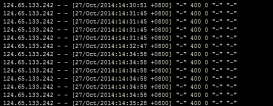Nginx配置虚拟主机支持3种方式:基于IP的虚拟主机配置,基于端口的虚拟主机配置,基于域名的虚拟主机配置。
详解Nginx 虚拟主机配置的三种方式(基于端口) http://www.zzvips.com/article/43829.html
详解Nginx 虚拟主机配置的三种方式(基于域名) https://www.zzvips.com/article/43830.html
1、基于IP的虚拟主机配置
如果同一台服务器有多个IP,可以使用基于IP的虚机主机配置,将不同的服务绑定在不同的IP上。
1.1 假设服务器有个IP地址为192.168.2.150,首先使用ifconfig在同一个网络接口上绑定其他3个IP。
|
1
2
3
4
5
6
7
8
9
10
11
12
13
14
15
16
17
18
19
20
21
22
23
24
25
26
27
28
29
30
31
32
33
|
[root@localhost ~]# ifconfig ens33:1 192.168.2.151/24 up[root@localhost ~]# ifconfig ens33:2 192.168.2.152/24 up[root@localhost ~]# ifconfig ens33:3 192.168.2.153/24 up[root@localhost ~]# ifconfigens33: flags=4163<UP,BROADCAST,RUNNING,MULTICAST> mtu 1500 inet 192.168.2.106 netmask 255.255.255.0 broadcast 192.168.2.255 inet6 fe80::2a8d:be6:a4a8:ea0 prefixlen 64 scopeid 0x20<link> ether 00:0c:29:16:90:ae txqueuelen 1000 (Ethernet) RX packets 1220 bytes 87955 (85.8 KiB) RX errors 0 dropped 0 overruns 0 frame 0 TX packets 206 bytes 23755 (23.1 KiB) TX errors 0 dropped 0 overruns 0 carrier 0 collisions 0ens33:1: flags=4163<UP,BROADCAST,RUNNING,MULTICAST> mtu 1500 inet 192.168.2.151 netmask 255.255.255.0 broadcast 192.168.2.255 ether 00:0c:29:16:90:ae txqueuelen 1000 (Ethernet)ens33:2: flags=4163<UP,BROADCAST,RUNNING,MULTICAST> mtu 1500 inet 192.168.2.152 netmask 255.255.255.0 broadcast 192.168.2.255 ether 00:0c:29:16:90:ae txqueuelen 1000 (Ethernet)ens33:3: flags=4163<UP,BROADCAST,RUNNING,MULTICAST> mtu 1500 inet 192.168.2.153 netmask 255.255.255.0 broadcast 192.168.2.255 ether 00:0c:29:16:90:ae txqueuelen 1000 (Ethernet)lo: flags=73<UP,LOOPBACK,RUNNING> mtu 65536 inet 127.0.0.1 netmask 255.0.0.0 inet6 ::1 prefixlen 128 scopeid 0x10<host> loop txqueuelen 1 (Local Loopback) RX packets 72 bytes 6252 (6.1 KiB) RX errors 0 dropped 0 overruns 0 frame 0 TX packets 72 bytes 6252 (6.1 KiB) TX errors 0 dropped 0 overruns 0 carrier 0 collisions 0 |
1.2 3个IP对应的域名如下,配置主机的host文件便于测试
|
1
2
3
4
5
6
7
|
[root@localhost ~]# vim /etc/hosts[root@localhost ~]# cat /etc/hosts127.0.0.1 localhost localhost.localdomain localhost4 localhost4.localdomain4::1 localhost localhost.localdomain localhost6 localhost6.localdomain6192.168.2.151 www.test151.com192.168.2.152 www.test152.com192.168.2.153 www.test153.com |
可以模拟实现DNS轮询的情况。
附:设置完hosts文件后一定要记得执行以下命令使其生效
1、windows下cmd进入命令行
|
1
2
3
4
5
|
C:\Users\1234>ipconfig /flushdnsWindows IP 配置已成功刷新 DNS 解析缓存。 |
1.3 建立虚拟主机存放网页的根目录,并创建首页文件index.html
|
1
2
3
4
5
6
7
8
9
10
|
[root@localhost /]# mkdir -p /data/www[root@localhost /]# cd /data/www[root@localhost www]# mkdir 151[root@localhost www]# mkdir 152[root@localhost www]# mkdir 153[root@localhost www]# echo "192.168.2.151" > 151/index.html[root@localhost www]# echo "192.168.2.152" > 152/index.html[root@localhost www]# echo "192.168.2.153" > 153/index.html[root@localhost www]# ls151 152 153 |
1.4 修改nginx.conf,将虚拟主机配置文件包含进主文件
|
1
2
3
4
5
|
[root@localhost /]# cd /usr/local/nginx/conf/[root@localhost conf]# lsfastcgi.conf fastcgi_params koi-utf mime.types nginx.conf scgi_params uwsgi_params win-utffastcgi.conf.default fastcgi_params.default koi-win mime.types.default nginx.conf.default scgi_params.default uwsgi_params.default[root@localhost conf]# vim nginx.conf |
在nginx.conf文件末尾加入以下配置
|
1
2
3
4
5
6
7
8
|
# 在http段中找到以下内容并删除每行前面的“#” log_format main '$remote_addr - $remote_user [$time_local] "$request" ' '$status $body_bytes_sent "$http_referer" ' '"$http_user_agent" "$http_x_forwarded_for"';# 配置文件结尾的最后一个“}”之前加入以下语句,如下所示include vhost/*.conf;} |
1.5 编辑每个IP的配置文件(每个虚拟主机的配置文件)
|
1
2
3
4
5
6
7
8
9
10
11
12
13
14
15
16
17
18
19
20
21
22
23
24
25
26
27
28
29
30
31
32
33
34
35
36
37
38
39
40
41
42
43
44
45
46
|
[root@localhost conf]# mkdir -p vhost[root@localhost conf]# cd vhost/[root@localhost vhost]# cat www.test151.conf server { listen 192.168.2.151:80; # 配置成实际的域名,每个虚拟主机的配置文件域名都相同 #server_name www.test.com; access_log /data/logs/www.test151.com.log main; error_log /data/logs/www.test151.com.error.log; location / { root /data/www/151; index index.html index.htm; } }[root@localhost vhost]# cat www.test152.conf server { listen 192.168.2.152:80; # 配置成实际的域名,每个虚拟主机的配置文件域名都相同 #server_name www.test.com; access_log /data/logs/www.test152.com.log main; error_log /data/logs/www.test152.com.error.log; location / { root /data/www/152; index index.html index.htm; } }[root@localhost vhost]# cat www.test153.conf server { listen 192.168.2.153:80; # 配置成实际的域名,每个虚拟主机的配置文件域名都相同 #server_name www.test.com; access_log /data/logs/www.test153.com.log main; error_log /data/logs/www.test153.com.error.log; location / { root /data/www/153; index index.html index.htm; } } |
1.6 创建日志文件,否则无法启动nginx
|
1
2
3
4
5
6
7
8
9
10
|
[root@localhost /]# mkdir -p /data/logs[root@localhost /]# touch /data/logs/www.test151.com.log[root@localhost /]# touch /data/logs/www.test151.com.error.log[root@localhost /]# touch /data/logs/www.test152.com.log[root@localhost /]# touch /data/logs/www.test152.com.error.log[root@localhost /]# touch /data/logs/www.test153.com.log[root@localhost /]# touch /data/logs/www.test153.com.error.log[root@localhost /]# ls /data/logs/www.test151.com.error.log www.test152.com.error.log www.test153.com.error.logwww.test151.com.log www.test152.com.log www.test153.com.log |
1.7 先测试配置文件然后再启动nginx
|
1
2
3
4
5
6
|
[root@localhost /]# cd /usr/local/nginx/sbin/[root@localhost sbin]# ./nginx -tnginx: the configuration file /usr/local/nginx/conf/nginx.conf syntax is oknginx: configuration file /usr/local/nginx/conf/nginx.conf test is successful# 启动nginx[root@localhost sbin]# ./nginx |
1.8 测试文件
|
1
2
3
4
5
6
|
[root@localhost sbin]# curl www.test151.com192.168.2.151[root@localhost sbin]# curl www.test152.com192.168.2.152[root@localhost sbin]# curl www.test153.com192.168.2.153 |
附:配置过程中出现的问题
1、测试配置文件时出现的问题
|
1
2
3
|
[root@localhost sbin]# ./nginx -tnginx: [emerg] unexpected "}" in /usr/local/nginx/conf/nginx.conf:122nginx: configuration file /usr/local/nginx/conf/nginx.conf test failed |
解决方法:下面语句忘记加分号
|
1
|
include vhost/*.conf; |
2、使用 curl www.test*.com 测试时总是访问到相同的结果
解决方法:不要将IP地址写在 server_name 后面, server_name 后面只能添加域名。
以上就是本文的全部内容,希望对大家的学习有所帮助,也希望大家多多支持服务器之家。
原文链接:https://blog.csdn.net/liupeifeng3514/article/details/79006998















